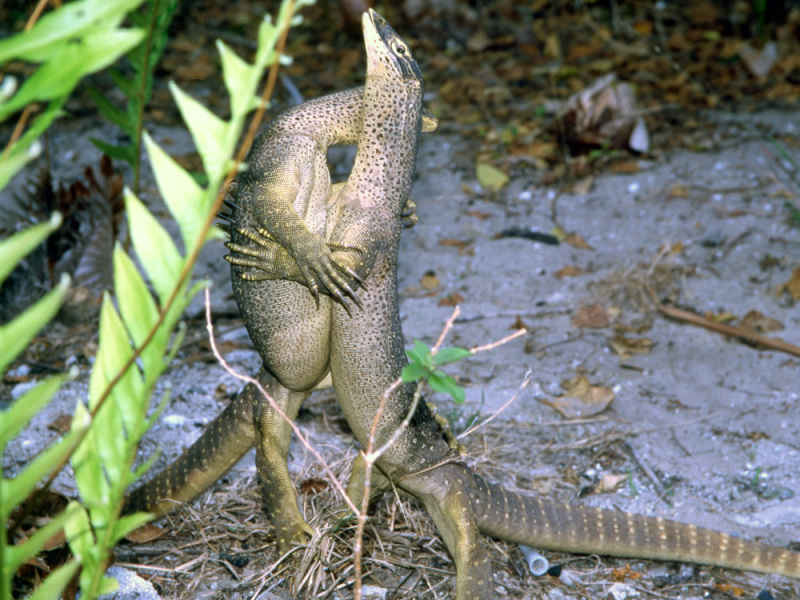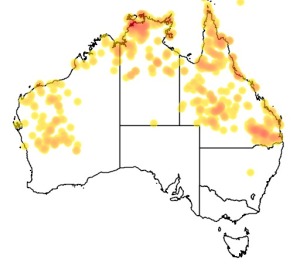�
�
�
���
Varanus panoptes
Yellow-spotted monitor
Kingdom
Animalia
Phylum
Chordata
Class
Reptilia
Order
Squamata
Family
Varanidae
Genus
Varanus
Species
Varanus panoptes
Status
unspecified
Colours
Distinguishing features
A large lizard with an elongate head and neck. Fingers and toes with well-developed claws. The tongue is often projected from the mouth and is strongly forked, and bluish in color. Body colouration consists of various shades of brown, with extensive light-colored spotting. Large cream or yellow spots have a dark center and are surrounded by a dark rim. The tail of most individuals is marked with narrow dark bands all the way to its distal end. In some individuals, banding is faint or absent at the extreme tip of the tail.
Size
- Up to 130 cm (Length of specimen) - applies to Total length
Synonyms
Similar taxa
-
Animalia:
Gould's Goanna (species: Varanus gouldii)
is a valid species found over much of Australia including the mainland coast near Lizard Island (Wilson and Swan, 2010). There are published records of that species at Lizard Island but the name is misapplied there. Varanus panoptes is the only goanna species in the Lizard Island Group. Its distribution overlaps that of Varanus gouldii on the mainland.
Distribution
Local abundance
- Lizard Island, Queensland, Australia: This species is abundant and common on Lizard Island. It can be found in most places on the island, from near the top of Cook's Look, down to to the beaches. Even casual observers walking the trails and roads on the island will notice the holes resulting from the digging behaviour of these large lizards. Footprint and tail drag marks also are readily seen in sandy areas. It is also found on Palfrey and South Islands in the Lizard Island Group. It was thought to be absent from South Island until Tanya Drury's record in 2017 showed otherwise. Ground-nesting terns were observed on South Island in the 1990s which seemed to indicate an absence of goannas at that time.
Web resources
Danger
- unspecified - Although they are normally wary of humans, if cornered or handled, these lizards can deliver a painful bite and extensive scratches from their claws. They should not be approached closely.
References
- Burger, T.D., R. Shao, L. Beati, H. Miller and S.C. Barker (2012). Phylogenetic analysis of ticks (Acari: Ixodida) using mitochondrial genomes and nuclear rRNA genes indicates that the genus Amblyomma is polyphyletic. Journal of Experimental Biology, 64: 45-55. LIRS catalog number 1600.
- Limpus, C.H. (1982). The reptiles of Lizard Island, Herpetofauna, 13(2): 1-6. LIRS catalog number 73.
- Llewelyn, J., L. Schwarzkopf, B.L. Phillips and R. Shine (2013). After the crash: How do predators adjust following the invasion of a novel toxic prey type? Austral Ecology, doi:10.1111/aec.12058. LIRS catalog number 1727.
- View all references








